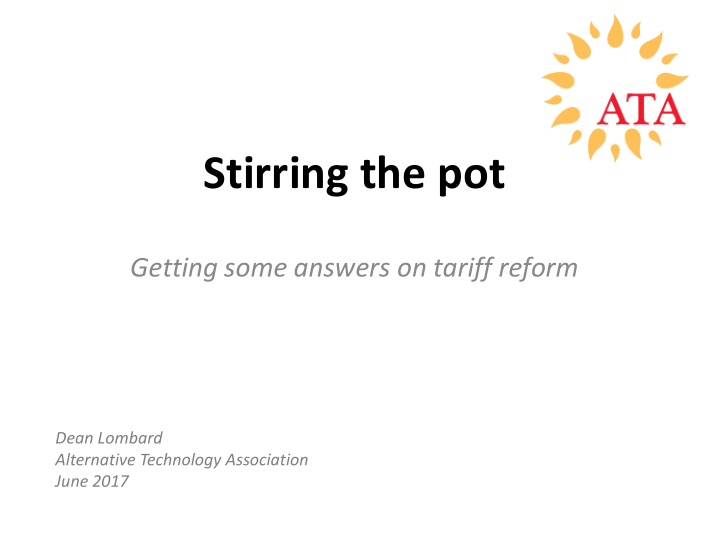



Stirring the pot Getting some answers on tariff reform Dean Lombard Alternative Technology Association June 2017
Why reflect network costs? In an energy market framework that seeks equitable cost and service outcomes for consumers and embodies the principle that no consumer should forego supply due to inability to pay , distribution of costs proportionate to how they are incurred promotes equity • Acute and chronic affordability problems can be addressed in a systematic and targeted way as a shared responsibility of market participants backed up by strong government social policy. Alternative Technology Association ― www.ata.org.au
What should users pay for? • A fair share of ongoing costs (sunk costs, operation, maintenance) • A fair share of future augmentation What does Long Run Marginal Cost include? • Could be anything – augex, repex, opex – for which changes in a customer’s usage change the timing or cost of the expenditure Alternative Technology Association ― www.ata.org.au
What drives network costs? • CitiPower: annual peak demand – largely by commercial and industrial loads • Paul Simshauser: air-conditioner accounts for 17% of household load but 64% of peak demand on ‘critical event’ summer days • Network price determinations: – Capex is 50-70% of Capex + Opex – Augex is 10-20% of Capex (30% for NSW regional) – Repex is 25-55% of Capex Alternative Technology Association ― www.ata.org.au
Who's cross-subsidising who? • High consumption cross-subsidises low consumption (sunk cost) • Flat consumption cross-subsidises peaky consumption (augmentation cost) • Undercharges: – high demand appliances used at network peak (aircon) – consumption reduction appliances that don’t affect peak (PV) • Discourages investment in stuff that: – reduces demand during peak (insulation, aircon cycling) – shifts demand from peak (battery + PV) Alternative Technology Association ― www.ata.org.au
How should networks charge? Ahmad Faruqui: For distribution- only utilities … a two -part rate: – Service charge (fixed) • Billing, metering and customer care – Demand charge • A reservation charge for transmission and distribution capacity • A reservation charge for generation capacity • A demand charge for actual utilization of capacity Paul Simshauser: A Three-Part Demand Tariff. The fixed charge is designed to cover fixed operating costs, a time-of-use variable rate to cover nominal variable costs, and a Demand Charge covering sunk costs based on coincident maximum demand. Hendrik S. Houthakker: A two-period TOU rate is better than a maximum demand tariff because the latter ignores the demand that is coincident with system peak. Alternative Technology Association ― www.ata.org.au
How should a customer’s demand be calculated? • Coincident peak? (i.e. peak that coincides with highest annual network peaks) – biggest driver of augex • Monthly/quarterly/seasonal peak? – customer’s outlier demand • Average peak? – customer’s typical demand (in aggregate, indicates minimum network capacity) Ergon: demand charge should probably be based on average demand, but that’s complicated and hard for customers to understand Alternative Technology Association ― www.ata.org.au
Tariff design principles James Bonbright: 1. Simplicity of tariff design 7. Avoidance of undue discrimination 2. Freedom from controversy as to proper 8. Static efficiency of rates interpretation (i.e. encourage optimum use and minimise waste) 3. Effectiveness in meeting total revenues 9. Reflection of all externalities 4. Revenue stability 10.Dynamic efficiency of 5. Tariff stability products in response to 6. Fairness in the technological innovation apportionment of sunk and changing demand- costs supply conditions Alternative Technology Association ― www.ata.org.au
The customer impact principle • Consult with customers first • Do a customer impact assessment • Introduce progressively to smooth cost change Alternative Technology Association ― www.ata.org.au
The customer impact principle 1.Consult with customers first 2.Do a customer impact assessment 3.Assess for equity, fairness, sense; adjust, repeat… (trade off cost reflectivity for fair customer outcomes) 4.Introduce progressively to smooth cost change Alternative Technology Association ― www.ata.org.au
Initial impact analysis Looking at impact of proposed cost-reflective tariffs on household loads typical of different types of households For most users, annual peak demand was between 2.5 and 7 times average daily peak demand; monthly or seasonal peak demand was still 2 – 4 times average. Under most of the networks' demand tariffs, households are being charged according to their outlier peaks on a handful of days per year, instead of their typical peaks. Alternative Technology Association ― www.ata.org.au
What we need to see • Clarification of the purpose of cost-reflective tariffs – Behaviour change? – Cost-distribution? • Clear info showing the relative contribution to network costs of annual and daily peak demand • Tariffs that reflect those costs – This could totally be average demand-based tariffs with critical peaks price/rebate aspect • Granular analysis of customer impacts including identification of systemic impacts and strategies for dealing with issues Alternative Technology Association ― www.ata.org.au
Thanks This project was funded by Energy Consumers Australia Dean Lombard (www.energyconsumersaustralia.com.au) as part of its Alternative Technology Association grants process for consumer advocacy projects and research dean@ata.org.au projects for the benefit of consumers of electricity and natural gas. The views expressed in this document do not necessarily reflect the views of Energy Consumers Australia. Alternative Technology Association ― www.ata.org.au
Recommend
More recommend